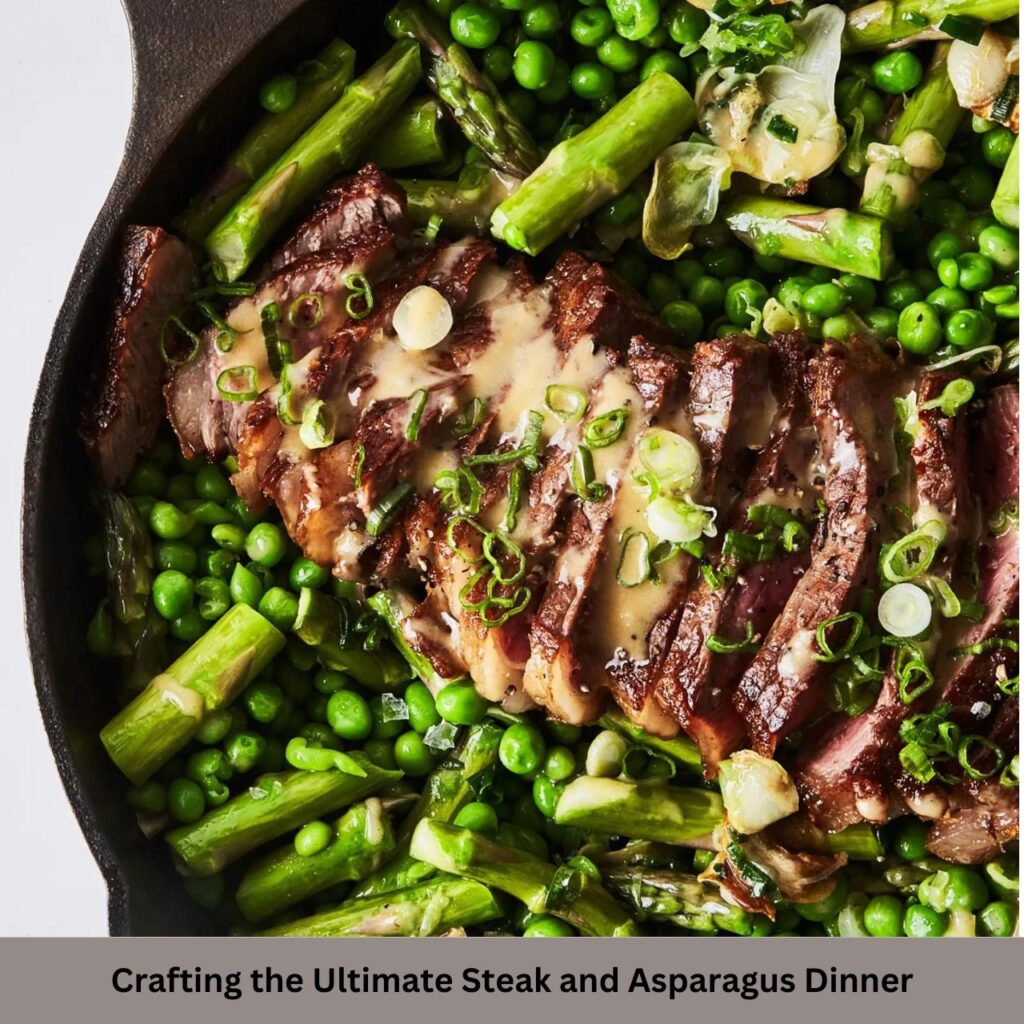Kimbap Recipe, the Korean rice roll wrapped in seaweed, is an ideal dish for busy home cooks. It’s versatile, easy to prepare, and can be adapted to fit almost any lifestyle. Unlike other dishes that require precise timing or constant supervision, kimbap offers flexibility. You can assemble it in stages, tailoring it to your taste and time constraints. It’s also a visually appealing meal that impresses, yet it’s simpler to make than it looks.
Beyond its aesthetic appeal, kimbap is portable, making it an excellent option for packed lunches or quick meals on the go. Whether you’re a working professional, a parent with a hectic schedule, or someone who wants a meal that’s both nutritious and convenient, kimbap checks all the boxes. Its layered flavors and textures—crisp vegetables, savory proteins, and seasoned rice—ensure that every bite is satisfying. Plus, once you master a few basic techniques, you can prepare it swiftly without much effort. Busy home cooks can enjoy not only a quick and easy meal but also a delicious one that doesn’t skimp on quality or nutrition.
The Time-Saving Benefits Of Kimbap Recipe

One of the most notable time-saving aspects of kimbap is how easily it can be customized with ingredients you already have. It’s a dish that thrives on versatility. You can transform leftovers into a fresh, exciting meal without the need for extensive preparation. Instead of juggling multiple pots and pans or laboring over complicated recipes. Kimbap allows you to consolidate ingredients into a single, neatly rolled package. This streamlined process is perfect for anyone looking to save time in the kitchen without sacrificing flavor.
Another huge time-saving benefit is Kimbap’s make-ahead potential. You can prepare various components in advance, like rice, vegetables, and proteins. Which means when you’re ready to eat, it only takes minutes to roll everything up. The ability to prep ahead and assemble quickly makes kimbap especially attractive for busy cooks who don’t have time to whip up a new meal from scratch every day. And because kimbap holds its shape well and tastes great even after several hours. It’s perfect for packed lunches or picnics. You can make it the night before, store it in the fridge, and enjoy a flavorful, homemade meal with zero morning hassle.
Essential Ingredients for Quick Kimbap Recipe
The essential ingredients for kimbap are straightforward yet crucial to achieving the dish’s signature flavor and texture. At its core, you’ll need sushi rice or short-grain rice, which provides the necessary stickiness to hold the roll together. Seasoning the rice with a touch of sesame oil, salt, and sometimes sugar is a small step. But it adds an authentic depth of flavor to your kimbap. Nori, the roasted seaweed sheets that envelop the rice and fillings. Is another must-have ingredient, offering a hint of brininess that balances the rich, savory fillings.
For fillings, the options are endless, but the traditional essentials include julienned carrots and spinach. Pickled radish (danmuji), and a protein source, often beef, fish cake, or egg. These vegetables not only provide color but also a satisfying crunch, complementing the softness of the rice. Proteins like cooked bulgogi, tofu, or crab sticks add substance, transforming kimbap into a complete, hearty meal. You’ll also need sesame seeds for sprinkling over the finished rolls, adding both flavor and a delightful texture. By keeping these core ingredients on hand, you can quickly assemble kimbap without running to the store or getting bogged down in complicated prep.
Prepping Vegetables Ahead for Faster Assembly
One of the easiest ways to streamline kimbap preparation is by prepping your vegetables in advance. Vegetables like carrots, cucumbers, and spinach are common in kimbap, but they require some slicing, blanching, or pickling to be kimbap-ready. Instead of tackling all this prep work at once, spend some time at the beginning of the week chopping and blanching your veggies. Julienned carrots can be stir-fried quickly and stored in an airtight container. Ready to be added to your rolls whenever needed. Spinach, after a brief blanching, can be seasoned and kept fresh for days.
The pickled radish, or danmuji, comes pre-prepared and only needs slicing, making it an easy vegetable to include. By having all your vegetables prepped and stored in the fridge. You can shave off valuable time when it’s time to assemble your kimbap. Not only does this advance prep speed up your rolling process. But it also ensures that you’re always ready to make a fresh batch of kimbap at a moment’s notice, even on your busiest days.
The Easiest Proteins To Use In Kimbap Recipe
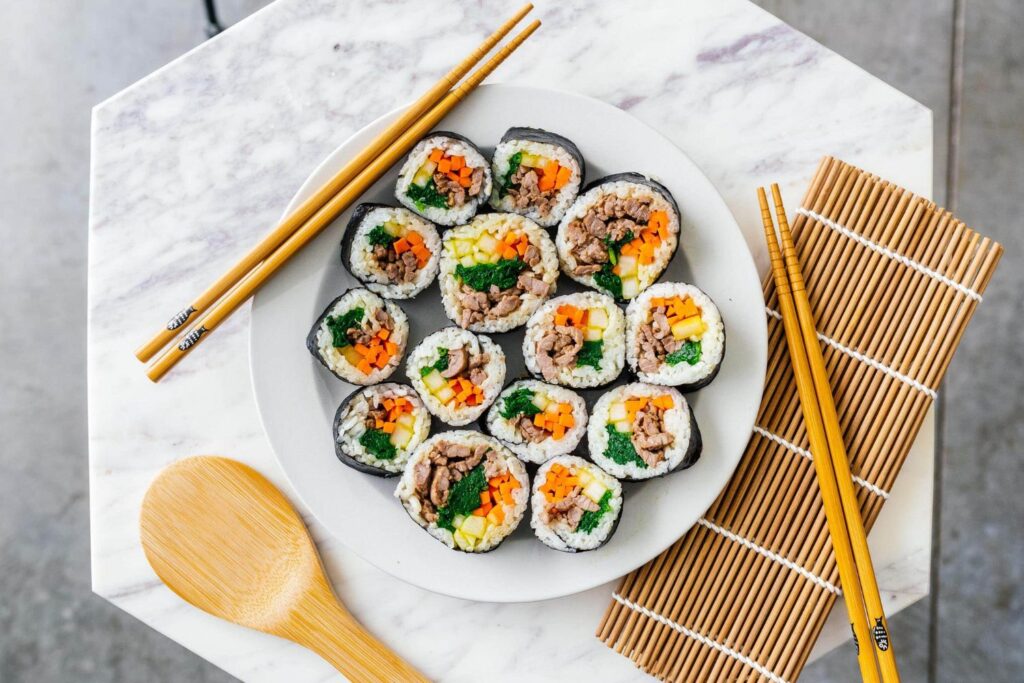
Choosing the right proteins for your kimbap can simplify or complicate your preparation. Fortunately, many proteins are easy to prepare in advance or even used straight out of the package. Eggs, for instance, are a common kimbap filling that can be whipped up quickly. A thin omelet, sliced into strips, makes for a fast and satisfying protein addition. Another great option is cooked crab sticks, which come ready to use and require no additional prep. For those who prefer plant-based options, tofu, when marinated and stir-fried, provides a chewy, savory filling that holds up well in the rolls.
Pre-cooked proteins like leftover grilled chicken or bulgogi are also perfect for busy home cooks. If you make a larger batch of protein at the beginning of the week, you can use it in various meals, kimbap included. Fish cakes, another traditional option, are easy to stir-fry and store, providing a quick. And flavorful protein that pairs well with other fillings. By selecting proteins that are either ready to use or easy to prepare ahead of time. You can significantly cut down your overall kimbap-making time.
Using Leftover Rice for Quick Kimbap Recipes
Leftover rice often poses a dilemma: it’s too dry to be served as is but too valuable to discard. Kimbap provides the perfect solution. Using day-old rice for kimbap works to your advantage. Freshly cooked rice can sometimes be too sticky or moist for rolling, making it difficult to work with. In contrast, slightly dried leftover rice has the right texture for spreading across your nori sheets without becoming overly soggy. Simply reheat the rice gently with a splash of water and season it with sesame oil. And a pinch of salt to revive its flavor.
Repurposing leftover rice for kimbap also eliminates one major step in the preparation process. Instead of waiting for fresh rice to cook and cool down. You can take the rice straight from your fridge and get rolling in minutes. This hack is especially useful for those who cook rice regularly and want to avoid waste. It also ensures that your kimbap comes together quickly when time is of the essence. By making the most of what you already have in your kitchen. You can transform leftovers into a delicious, wholesome meal without starting from scratch.
Make-Ahead Kimbap Fillings That Save Time
To truly streamline your kimbap preparation, make-ahead fillings are your best friend. You can prepare certain ingredients in large batches and store them for future use. For example, blanch spinach, season it lightly with sesame oil and soy sauce, and store it in the fridge for up to a week. You can also stir-fry carrots, cook fish cakes, or season beef in advance and portion them as needed.
Egg strips, another classic filling, can be cooked in bulk, refrigerated, and used throughout the week. These fillings are versatile and can be repurposed in other dishes, ensuring nothing goes to waste. The key to making ahead is proper storage: airtight containers or zip-top bags can keep your ingredients fresh while separating them into smaller portions makes it easy to grab what you need. By having these components ready, assembling the kimbap becomes quick. And seamless tasks, perfect for busy days when time is at a premium.
Shortcuts For Rolling Kimbap Recipe Perfectly Every Time
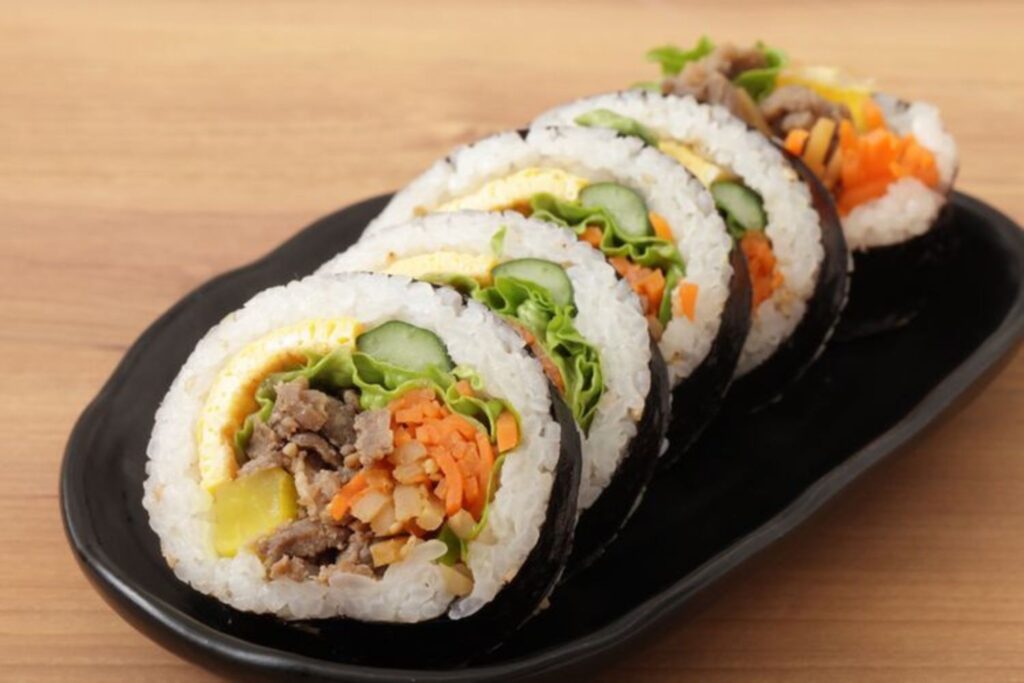
Rolling kimbap may seem intimidating at first, but there are a few clever shortcuts that can make the process much easier, even for beginners. One of the most important tools you can use is a bamboo mat or makisu. Which helps guide your rolling and ensures a uniform, tightly packed result. However, if you don’t have a bamboo mat on hand, don’t worry—plastic wrap can also be used as an alternative. Simply place the nori sheet on the plastic wrap, and layer on your ingredients. And use the wrap to roll everything tightly without the need for specialized tools.
Another trick is to be mindful of how you distribute the ingredients. Spread the rice evenly but thinly across the nori, leaving a little space at the top to seal the roll. Overloading the roll with too many fillings can cause the kimbap to fall apart, so aim for balance—less is more when it comes to the fillings. If your kimbap is still falling apart, you can use a light dab of water or rice vinegar to help seal the nori, ensuring that the roll stays intact. With practice and a few of these shortcuts, you’ll find that rolling kimbap becomes a fast, foolproof process that you can master in no time.
Creative Kimbap Fillings You Can Make in Minutes
While traditional kimbap fillings like carrots, spinach, and bulgogi are delicious. There’s plenty of room to get creative and experiment with new ingredients. One quick and unconventional option is to use avocado. Which adds a creamy texture and pairs beautifully with the salty nori and seasoned rice. You can also incorporate leftover grilled vegetables such as bell peppers or zucchini for a unique flavor twist. Smoked salmon, cream cheese, or even hummus can be used for a fusion-inspired version of kimbap that’s both exciting and easy to make in a pinch.
For those looking to add a bit more spice, try using kimchi as a filling—it is tangy. Fermented flavor provides a punch that lights up the roll. Canned tuna mixed with a bit of mayo and sriracha is another quick and flavorful addition. Offering a satisfying protein that requires minimal prep. These creative fillings can be made in minutes and are perfect for when you want to break away from the traditional recipe while still keeping the process quick and simple. The possibilities are endless, and this flexibility is what makes kimbap such a versatile dish for busy cooks looking to whip up something fresh and flavorful without spending hours in the kitchen.
Utilizing Pre-Cut Veggies for Speedy Kimbap
One of the easiest ways to cut down on preparation time for kimbap is by using pre-cut vegetables. Many grocery stores offer ready-to-use, julienned vegetables such as carrots, cucumbers, and bell peppers. Which can significantly reduce the time it takes to prep your fillings. By purchasing pre-cut veggies, you can skip the peeling, slicing, and dicing, allowing you to focus on assembly. This shortcut is especially handy for busy home cooks who may not have the time or energy to prep everything from scratch.
In addition to store-bought pre-cut veggies, frozen vegetables can also be a lifesaver when you’re short on time. Frozen spinach, for instance, can be quickly thawed and seasoned to use as a filling. Frozen stir-fry veggie blends also offer a wide variety of pre-chopped options that can be sautéed in minutes and added to your kimbap. The key is to choose vegetables that will maintain their texture and flavor after freezing or pre-cutting. Ensuring that your kimbap still tastes fresh and vibrant. By using pre-cut or frozen veggies, you’ll find that assembling kimbap becomes a much faster, less labor-intensive process.
How to Choose The Best Rice For Kimbap Recipe?
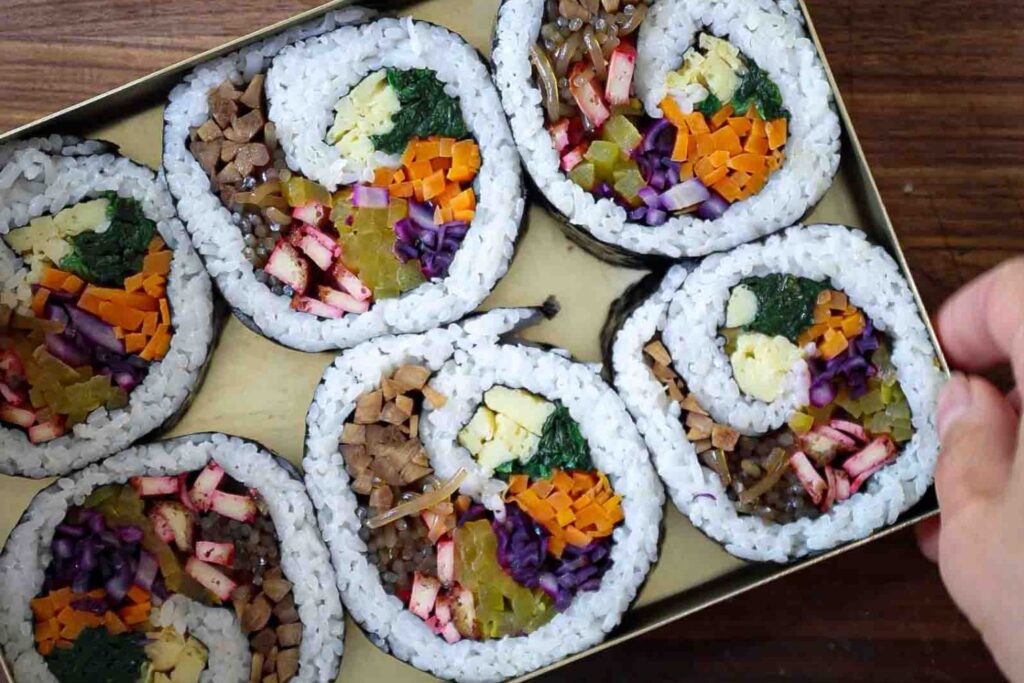
Selecting the right price is essential to making kimbap that holds together well and tastes delicious. The best choice for kimbap is short-grain rice or sushi rice, which has a sticky texture that allows it to adhere to the nori and the other ingredients. Long-grain rice or basmati, while great for other dishes, won’t work as well for kimbap because they don’t have the stickiness needed for rolling.
When cooking the rice, it’s important not to overcook or undercook it. Rice that’s too mushy will make the kimbap soggy and hard to roll, while rice that’s too dry won’t bind well with the other ingredients. After cooking, the rice should be seasoned lightly with sesame oil and salt. Some people also add a small amount of rice vinegar or sugar to give the rice a subtle sweetness and tang, enhancing the overall flavor of the kimbap.
Once the rice is ready, let it cool to room temperature before using it in your kimbap. Hot rice can cause the nori to wilt or tear, making it difficult to roll. Cool, seasoned rice ensures that your kimbap stays firm and flavorful, holding its shape perfectly. By choosing the right rice and preparing it properly, you’ll set the foundation for a flawless kimbap every time.
The Best Store-Bought Proteins for Kimbap Recipe
Store-bought proteins are a busy cook’s secret weapon when it comes to making kimbap in a hurry. Canned tuna, for instance, is a popular and convenient option that requires little to no preparation. Simply mix it with a bit of mayo, sesame oil, and salt for a quick and tasty filling. Another great store-bought option is crab sticks, which are often used in traditional kimbap. These imitation crab sticks are ready to use straight out of the package. Making them an ideal protein for quick assembly.
Pre-cooked or marinated meats like rotisserie chicken, grilled shrimp, or even deli meats can also be used as protein-packed fillings. These options are not only time-saving but also offer a variety of flavors that can elevate your kimbap. Tofu, whether smoked, marinated, or fried, is another store-bought protein that works well in both vegetarian and non-vegetarian versions of kimbap. The key is to choose proteins that complement the other ingredients and don’t require extensive prep. Allowing you to put together a satisfying meal in a fraction of the time it would take to cook everything from scratch.
Time-Saving Kimbap Rolling Techniques
When it comes to rolling kimbap quickly, technique plays a huge role in how efficiently you can prepare the dish. Start by laying down a sheet of nori on a bamboo rolling mat. If you don’t have a bamboo mat, you can use plastic wrap or even a clean kitchen towel as a substitute. Spread a thin, even layer of rice across two-thirds of the nori sheet, leaving the top third free to seal the roll later. Press the rice down gently but firmly to ensure it sticks well without being too thick, which can make rolling difficult.
Next, place your fillings in a straight line across the middle of the rice layer. The key here is not to overfill the roll—too many ingredients will make the roll burst open or become difficult to handle. As you start rolling, use the bamboo mat or plastic wrap to guide the nori and rice tightly around the fillings. Keep pressing down lightly to ensure the roll is compact and firm. Once you’ve rolled it all the way, use a little water on the top edge of the nori to seal the roll securely. With practice, you’ll find that this technique becomes second nature, allowing you to roll kimbap quickly and efficiently.
Using Frozen Ingredients For Faster Kimbap Recipe Prep
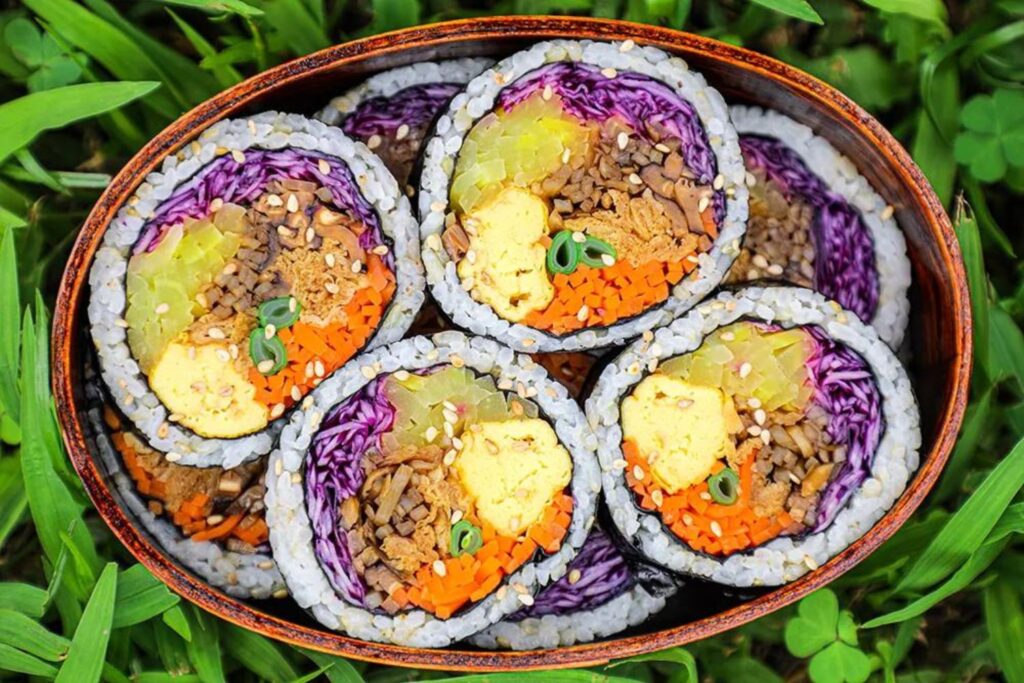
Frozen ingredients can be a real time-saver when making kimbap, especially if you have a busy schedule. For example, thaw and season frozen spinach with sesame oil and soy sauce to provide a quick and nutritious filling. You can also use pre-cooked frozen shrimp or fish cakes, which require minimal prep before adding them to your kimbap rolls. Keep these frozen items in your freezer for months to ensure you always have something ready when you crave kimbap.
Frozen vegetables like bell peppers, corn, or edamame are another way to cut down on prep time. They can be quickly sautéed or steamed and then added to your kimbap for a burst of flavor and color. Using frozen ingredients doesn’t compromise the quality of your kimbap, and in many cases, it can make the entire process much more manageable for a busy home cook. By relying on frozen components, you can enjoy the flavors of kimbap without having to spend hours in the kitchen prepping fresh ingredients every time.
Make-Ahead Sauces and Seasonings for Kimbap
Sauces and seasonings play an important role in enhancing the flavor of kimbap and making them ahead of time can save you precious minutes during assembly. One essential seasoning is the sesame oil mixture used to flavor the rice. You can prepare a larger batch of this by mixing sesame oil, salt, and a bit of sugar in a jar, and storing it in your fridge for when you’re ready to season your rice. This way, you don’t have to measure and mix ingredients every time you make kimbap.
Soy sauce-based dipping sauces are another great make-ahead option. Combine soy sauce, rice vinegar, sesame oil, and a pinch of sugar in a bottle, and you’ve got a ready-to-go dipping sauce for your kimbap. For those who enjoy a bit of spice, preparing a small batch of gochujang (Korean red chili paste) mixed with sesame oil and honey can serve as both a filling ingredient and a dipping sauce. These sauces keep well in the refrigerator, allowing you to grab them whenever you’re ready to roll your kimbap. By having these flavor boosters prepped in advance, you’ll add depth to your Kimbap recipe without adding any extra work during assembly.
Packing Kimbap for On-the-Go Meals
Kimbap is a perfect meal to take on the go, whether for lunch at work, a picnic, or a quick snack during a busy day. To ensure your kimbap stays fresh, it’s important to pack it properly. Start by slicing the rolls into bite-sized pieces and placing them in an airtight container. If you’re worried about the rolls drying out, you can wrap each roll individually in plastic wrap before slicing. This keeps the moisture locked in and prevents the rice from becoming stale.
To keep your kimbap from sticking together in the container, you can place a piece of parchment paper or a leaf of lettuce between the layers. This simple barrier ensures that the rice doesn’t become gummy or the nori soggy. For added freshness, store any sauces separately in small containers or squeeze bottles. This way, the kimbap remains crisp and doesn’t absorb too much moisture during transport.
If you plan to eat the kimbap several hours later, refrigerate it until you’re ready to go. Kimbap is unique in that it holds up well for hours, making it an ideal choice for meal prep or on-the-go lunches. However, if you’re storing it for more than a day, be sure to rewrap it tightly in plastic wrap and refrigerate it to maintain its freshness. These small packing steps will ensure that your kimbap remains delicious, moist, and satisfying even after a few hours in transit.
Storing Kimbap Recipe For Freshness Throughout the Week
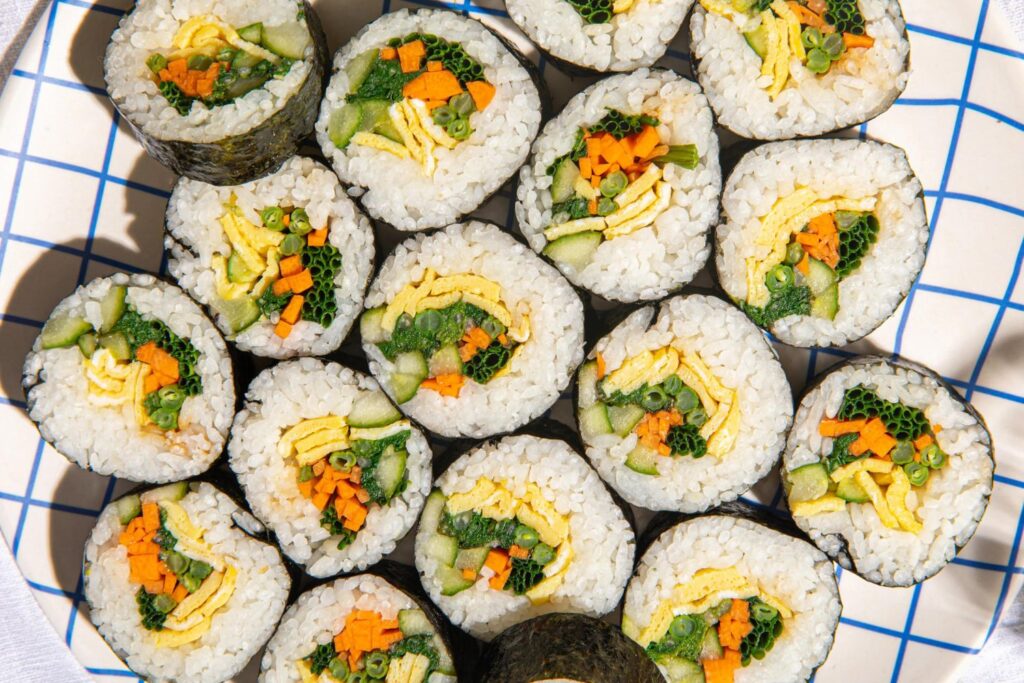
Kimbap can be made in advance and stored for several days, making it a convenient option for meal prep. The key to keeping your Kimbap recipe fresh throughout the week is proper storage. After rolling and slicing your kimbap, wrap each roll tightly in plastic wrap. This prevents the rice from drying out and helps maintain the softness of the nori. Once wrapped, store the rolls in an airtight container in the refrigerator to keep the fillings and rice from absorbing unwanted moisture or odors from the fridge.
For best results, try to consume your kimbap within two to three days. After this time, the rice may start to harden, and the nori could lose its texture. If you’re planning to store the kimbap for longer, freezing individual rolls is another option. Place the wrapped rolls in a freezer-safe bag, ensuring that they are tightly sealed. When you’re ready to eat, thaw them in the refrigerator overnight and give them a light reheat, if needed. With proper storage, you can enjoy fresh-tasting kimbap all week long without sacrificing quality.
Using a Bamboo Mat vs. Alternatives for Rolling
The bamboo mat, or makisu, is the traditional tool used for rolling kimbap, and it’s highly effective for creating tight, uniform rolls. The mat allows for even pressure as you roll, ensuring that the kimbap stays compact and doesn’t fall apart when sliced. If you’re a beginner, using a bamboo mat can make a big difference in achieving a professional-looking kimbap. The mat is reusable, easy to clean, and stores easily, making it a great investment for those who plan to make kimbap regularly.
However, if you don’t have a bamboo mat on hand, there are plenty of alternatives. A piece of plastic wrap or parchment paper can work as a substitute, allowing you to roll the kimbap without sticking. Simply place the nori on the wrap, add your fillings, and use the wrap to guide the rolling process. A clean kitchen towel can also work in a pinch, especially if you need something sturdy to help shape the roll. While these alternatives may not provide the same level of precision as a bamboo mat. They still allow you to roll kimbap with minimal fuss.
How to Keep Kimbap Moist and Flavorful
One of the challenges of making kimbap ahead of time is ensuring that it stays moist and flavorful. To keep the rice from drying out, make sure you store the rolls properly in plastic wrap or an airtight container. The rice itself should be seasoned with a touch of sesame oil, which helps lock in moisture and adds a rich, nutty flavor to each bite. This simple step not only enhances the taste of the rice but also helps prevent it from becoming too dry during storage.
For the fillings, avoid using ingredients that are too wet, as they can make the nori soggy. Instead, opt for lightly cooked or blanched vegetables, firm proteins like tofu or eggs, and well-drained pickled radish. If you want to keep the kimbap extra flavorful, pack a small container of dipping sauce on the side. A mixture of soy sauce, sesame oil, and a pinch of sugar can add a burst of flavor when drizzled over the kimbap just before eating. By paying attention to both moisture and flavor, you can ensure that your kimbap remains delicious and satisfying even after a few days in the fridge.
Kimbap Recipe Variations For Busy Cooks
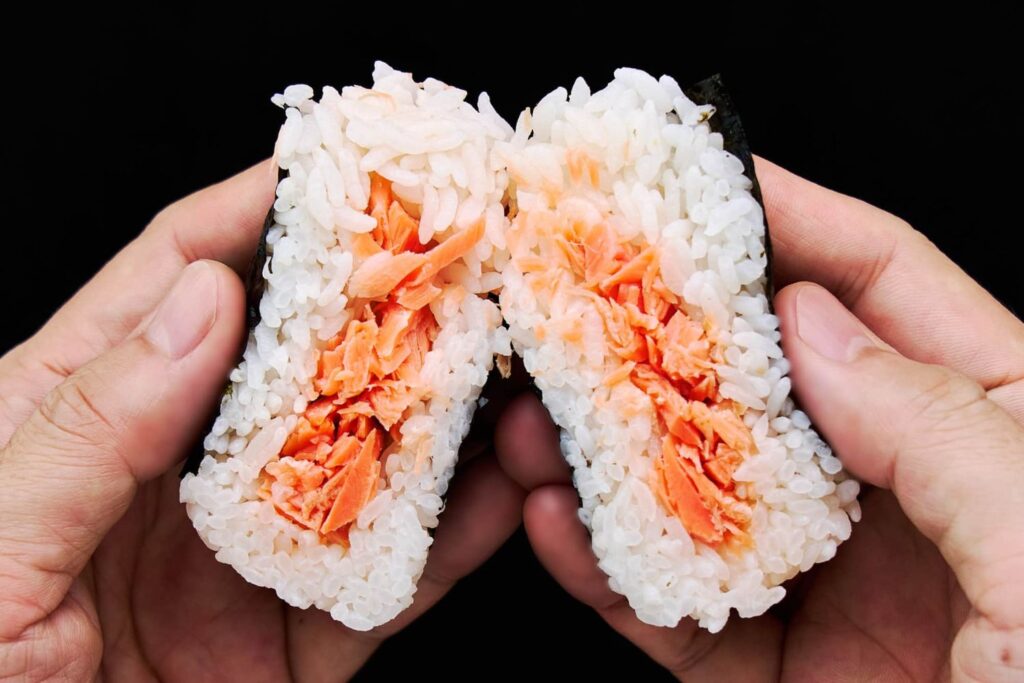
While traditional kimbap recipes are always a favorite, busy home cooks can experiment with variations to suit their tastes and schedules. For a quick and healthy option, try making a veggie-packed kimbap using pre-chopped greens, carrots, and avocado. The simplicity of this version makes it perfect for those looking for a lighter, faster meal without compromising on flavor. You can also switch up the rice by using brown rice or quinoa for a more nutritious twist that adds fiber and a heartier texture to your rolls.
If you’re in the mood for a fusion take, try incorporating global flavors into your kimbap. Add ingredients like smoked salmon, cream cheese, or roasted vegetables for a Mediterranean spin, or use spicy sriracha mayo and canned tuna for a bold, quick-fix option. Busy cooks can also take advantage of convenience foods like rotisserie chicken or pre-marinated tofu to make the kimbap assembly even faster. The beauty of the Kimbap recipe lies in its flexibility—you can adapt the recipe to fit your preferences and the ingredients you have on hand, making it a go-to meal for any day of the week.
One-Pan Kimbap Recipes for Quick Cleanup
Busy home cooks looking to simplify the kimbap-making process can opt for one-pan recipes that minimize cleanup. Instead of using multiple pots and pans to prepare each ingredient separately, combine everything in a single skillet. Start by sautéing your proteins and vegetables together, seasoning them lightly with sesame oil and soy sauce. Once the fillings are ready, remove them from the heat and let them cool slightly before rolling. This method not only saves time but also reduces the number of dishes you’ll need to clean up afterward.
For even more efficiency, you can cook your rice in a rice cooker while you prepare the fillings, streamlining the process. The beauty of one-pan kimbap recipes is that they maintain all the flavor and freshness of traditional kimbap while simplifying the cooking process. This approach is perfect for weeknights when time is limited. And you still want to enjoy a home-cooked meal with minimal fuss.
The Best Way to Reheat Kimbap Without Losing Taste
Reheating kimbap can be tricky, as you want to preserve the flavor and texture without making the nori soggy. One of the best ways to reheat the Kimbap recipe is by using a microwave on a low setting. To prevent the rice from drying out, cover the kimbap with a damp paper towel before heating. This will add moisture back into the rice while keeping the roll intact. Heat in short intervals, checking frequently to ensure it doesn’t overheat.
Alternatively, you can lightly pan-fry the kimbap in a skillet with a bit of oil. This method not only reheats the kimbap but also gives the nori a crispy, toasted texture that enhances the overall flavor. If you’ve frozen the kimbap, thaw it in the refrigerator overnight before reheating it to maintain the best texture and taste. With the right reheating technique, you can enjoy your kimbap fresh out of the fridge or freezer without losing any of its original deliciousness.
Kimbap Freezing Tips For Meal Prep Success
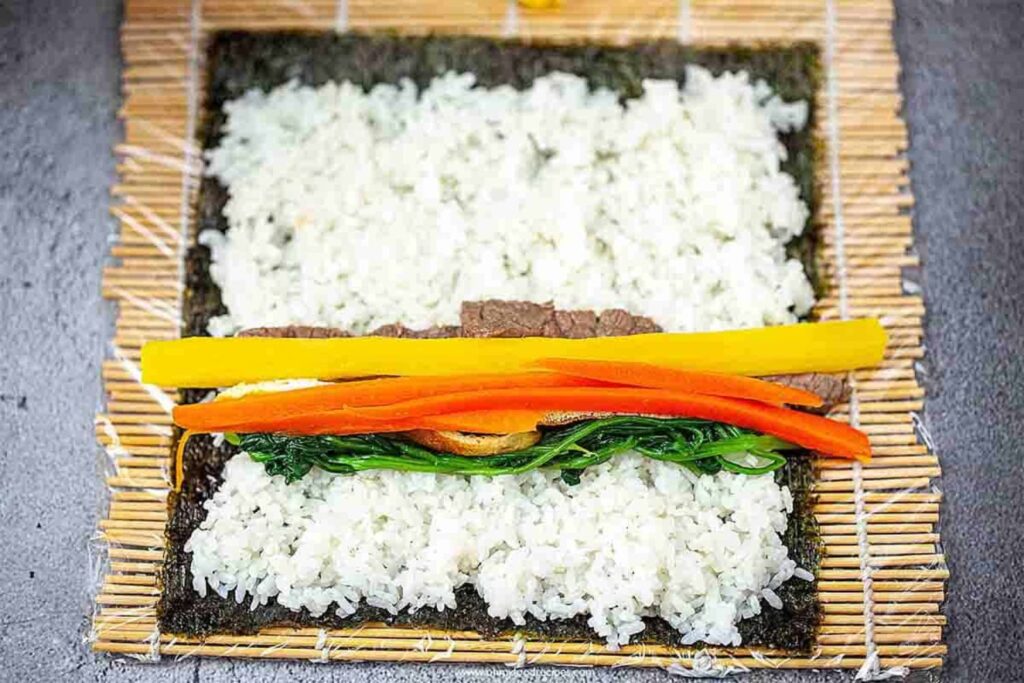
For those who want to prepare kimbap in bulk, freezing is an excellent option to ensure that you always have a quick meal ready. To freeze kimbap, first wrap each roll tightly in plastic wrap to maintain its shape and prevent freezer burn. After wrapping, place the rolls in a freezer-safe bag, squeezing out as much air as possible. Label the bags with the date, so you know when they were made. And try to use them within one to two months for the best flavor and texture.
When you’re ready to enjoy frozen kimbap, transfer the rolls to the refrigerator to thaw overnight. Once thawed, you can either eat the kimbap cold or reheat it using a microwave or skillet. Freezing allows you to batch-make kimbap, saving time in the future while still enjoying a homemade meal. By mastering these freezing tips, you can streamline your meal prep. And have the Kimbap recipe on hand whenever hunger strikes, no matter how busy your schedule gets.
Creative Ways to Use Kimbap Leftovers
Leftover kimbap can be repurposed into a variety of creative and delicious dishes, ensuring that nothing goes to waste. One easy way to enjoy leftover kimbap is to slice it and lightly pan-fry the pieces in sesame oil. Creating crispy kimbap bites with a savory, toasted flavor. These make for a great snack or appetizer. You can also turn leftover kimbap into a kimbap stir-fry by chopping up the rolls. And sautéing them with extra vegetables and soy sauce. This transforms the Kimbap recipe into a completely new dish with minimal effort.
Another idea is to chop up the kimbap and add it to a salad. Giving your greens an added boost of flavor and texture. If you have leftover fillings that didn’t make it into the rolls, you can use them to make quick fried rice or even soup. Adding variety to your meals without needing to start from scratch. By thinking outside the box, you can breathe new life into your kimbap leftovers and reduce food waste at the same time.
Kimbap Recipe as a Healthy, Quick Lunch Option
Kimbap is a fantastic option for those seeking a healthy and convenient lunch. Packed with vegetables, lean proteins, and nutritious seaweed, the Kimbap recipe provides a balanced meal that’s light yet filling. The rice component offers energy-sustaining carbohydrates, while the nori delivers important vitamins and minerals such as iodine and iron. Plus, kimbap is highly customizable, allowing you to include ingredients that align with your dietary preferences and nutritional goals.
Whether you’re preparing kimbap for a busy workday, school lunch, or weekend outing. It offers an easy, grab-and-go solution that doesn’t sacrifice nutrition. Unlike other fast food options, kimbap is low in calories and high in nutrients. Making it an excellent choice for health-conscious individuals. By incorporating a variety of colorful vegetables, plant-based proteins, and flavorful sauces. You can enjoy a delicious and nourishing meal that keeps you fueled throughout the day.
YouTube Video
Conclusion
Mastering kimbap hacks is a game-changer for busy home cooks. From prepping ingredients in advance to using time-saving tools and techniques. There are countless ways to streamline the kimbap-making process without compromising on taste or quality. By integrating these simple yet effective strategies into your cooking routine, you can enjoy fresh, homemade kimbap with minimal effort.
Whether you’re making kimbap as a quick weeknight meal, or prepping it for on-the-go lunches. Experimenting with creative variations, these hacks will help you save time while still delivering delicious results. Kimbap is not only a versatile dish but also a fun and rewarding one to make. Offering endless opportunities for customization. With a little practice and the right tricks, you can become a Kimbap recipe expert in no time. Turning this beloved Korean dish into a regular part of your busy lifestyle.

